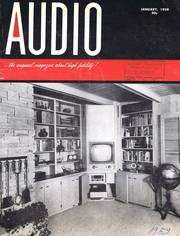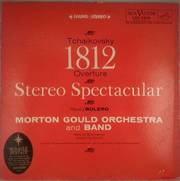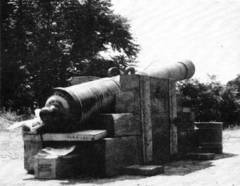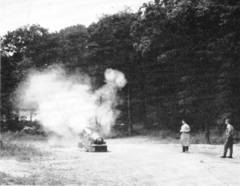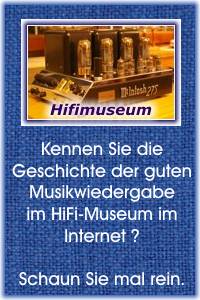Erläuterungen zu diesen US-AUDIO Seiten der 1950er Jahre
Die hier stehenden amerikanischen Artikel aus 1959 (aus der US-AUDIO) sind teilweise sehr gewöhnungsbedürftig, weil sie erstens aus einer längst vergangenen Zeit stammen und zweitens, weil dort in den USA ganz "anders" gedacht wurde als bei uns in Old Germany oder in Europa.
Vergleichbar mit unseren deutschen Hifi-Magazinen etwa ab 1962 ist jedoch, daß auch dieses Audio-Magazin ihre Anzeigen- Kunden und -Leser am Markt oder von anderen Magazinen (be- oder ab- ?) werben mußte. - Weiterhin sind die riesigen Dimensionen des amerikanischen Kontinents mit unseren hier in Europa nicht vergleichbar. - Ein Redaktions-"Trip" von New York nach Los Angeles oder Chicago oder gar in die Wüste nach Las-Vegas zu einer der CES- Audio- "Shows" war - auch mit dem Flugzeug - immer noch eine halbe Weltreise. Und jede Ausstellung oder "Messe" wurde als "Show" deklariert. Und natürlich, in USA musste alles "Show" sein, um beim Publikum einige Aufmerksamkeit zu erzeugen.
.
ABOUT MUSIC - West Point Revisited
In the history of extra-musical sounds on LP, we haye heard the roar of sports car engines, the woosh of jet planes, the downpour of tropical thunderstorms, street noises, heart beats, and bird calls. But the biggest impact on the record market was made by a gun, specifically a "French siege cannon", vintage 1761, of the type used by Napoleon during his 1812 Russian campaign.
This weapon was recalled into service after a century's retirement in order to carry out a musical, rather than a military mission. As such, it played a vital role in making Mercury's recording of Tchaikovsky's Overture 1812 (in its original scoring with cannon and bells) the best-selling LP of the past two years.
In audio shows throughout the land, the shots of this now-famous cannon resounded in the booths and corridors, even out-roaring the steam locomotives.
At the New York High Fidelity Show (1956), for example, hordes of visitors squirmed their way into the Mercury exhibit room to hear the 16 cannon shots and the clamorous bell-ringing at the climax of the Overture 1812, staying on to listen attentively to Deems Taylor's description of the manner in which the "effects" were synchronized with the musical track.
.
Krach aus der Overtüre 1812 von Peter Tschaikowski
The monophonic version of 1812 was recorded by Mercury late in 1954, only months before the company began its three-channel stereo recording program.
With the advent of commercial stereo tapes and discs, plans were made to re-record the work in stereo. Finally, in early April, 1958, Mercury returned to Minneapolis where Antal Dorati conducted the Minneapolis Symphony Orchestra and the University of Minnesota Brass Band in a repeat performance of the redoubtable war-horse for the benefit of the stereo microphones.
The following month, Mercury's crew scaled the heights of the Riverside Church to capture the sound of the Laura Spelman Rockefeller Memorial Carillon (Audio, July, 1958). And in mid-July, Mercury revisited West Point for the third and final stage of its 1812-stereo expedition.
On that hot and muggy day, six shots were fired and recorded in stereo. The site of the firing was near Building 706 and Delafield Road at the U. S. Military Academy, West Point. For the stereo edition of the Overture 1812, the cannon previously used in the monophonic version was passed over in favor of a larger weapon.
Eine 12-Pfünder Sieger Kanone
After carefully studying the matter, Gerald C. Stowe, Chief Curator of the West Point Museum, settled on a 12-pounder "siege cannon" built in Douay, France in 1775. The inscription near the muzzle reads, "Le Constant" (The Faithful).
It is more than likely that this field piece is a veteran of the Napoleonic Wars. Later, it was purchased by the Mexican government and used against American troops at the battle of Contreras on August 20, 1847, at which time it was captured and brought to the United States, eventually taking its place alongside the other war trophies at the West Point Military Academy. The Academy, incidentally, is one of the few places in the world where such field pieces are kept serviceable.
Two factors dictated Mr. Stowe's choice: size and solidity. The size of this muzzle-loaded cannon promised a truly enormous blast. Equally important, there was practically no danger of cracking, despite its 183 years; the bronze construction guaranteed that.
The cannon having been selected, a naval-type carriage was then built for the firing base. Since the old artillery piece weighed over 3.000 pounds (1,5 Tonnen), heavy oak timbers had to be employed as shown in Fig. 1. Coarse black powder of a century-old battle formula was placed in one- and two-pound paper bags, and the cannon was moved from Trophy Point to the firing site.
Der Mercury's recording truck
By the time Mercury's recording truck had arrived on the scene at 8:00 a.m. on the day of the firing, the roads nearby had been blocked off and an ambulance and safety crew were standing by. Taking no chances, the driver parked the truck behind Building 706. The three microphones used for the original three-channel, half-inch tape masters were strung from ropes hung between trees.
The microphones were later covered with handkerchiefs to protect them from the blasts. Damp newspapers were used for wadding, and the first charge was rammed down the barrel. The fuse was lit, and all but a few intrepid souls moved away from the cannon, plugging their ears.
The first shot, Fig. 2, was a resounding success. The aftermath of the explosion reverberated in the valley below. For the next shot, a slightly larger charge was employed, and the position of the microphones altered somewhat. Shots 2 and 3, however, were marred by a metallic ringing that was eventually traced to an oil tank located several yards from the left microphone. The gun crew rolled the offending tank down a hillside and got ready for the next shot. This one was free of the ringing but lost its "punch" because of improper wadding.
.
Dann erstmal ein lunch - bevor wieder "geschossen" wird ...
By now, it was time for lunch. Wilma Cozart (Mercury's young vice president in charge of the classical division) fetched a very large picnic basket from the car and we all settled down to Southern fried chicken, deviled eggs, chocolate layer cake, fresh fruit, and soft drinks.
As there didn't seem to be any waste cans in the vicinity, someone jokingly suggested putting the refuse in the barrel of the cannon. This turned out to be precisely what Curator Stowe recommended, to our amazement, a few minutes later: "It's perfectly all right, the cannon will pulverize it."
Now the cannon, with its garbage and damp-newspaper wadding, was loaded for the fifth shot. In the wake of the blast, chicken bones, cardboard plates, and apple cores floated down upon us in burnt-flake, pulverized form, and we were too busy brushing off the fall-out to evaluate the sound of the explosion. After a sixth shot, it began to rain, and the drops splattering on the sensitive Telefunken microphones made further recording impossible.
On re-hearing the tapes in New York, it was decided to use the very first shot, because this one had the biggest "boom" of all. The cannon tape and the carillon recording were edited, synchronized musically with the symphonic performance, and a two-channel stereo tape made from the various three-channel stereo masters. The two-channel master transfer from the original three-channel tapes was made in a single step, utilizing a 10-position console and five tape machines.

